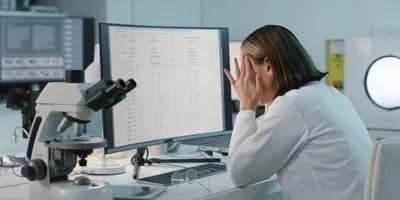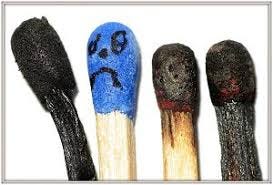Aim
To shed light on the often-overlooked issue of burnout among medical laboratory scientists (MLS) and how it can be mitigated.
Given
Burnout, Medical Laboratory Scientists (MLS), Stress, Mental Health, Work-Life Balance, Supportive Environment
Method
Expository article
Principle
For months, Faith prayed, fasted, and hoped against hope for the one thing that stood in her way of professional progress as a Medical Laboratory Scientist — internship placement. Soon enough she got a place and while to her mother it was a case of "What God cannot do doesn’t exist”, it was slowly beginning to feel like a blessing and a curse. As Faith fiddled with the keypads of her mobile phone, she poured out her frustration to her friend via their WhatsApp chat. “Should I say God should not have answered?” She typed.
Faith’s reality took its first toll as she started to feel like a heavy chain was hanging down her neck just a few months in. “I come home each day feeling so tired that all I want to do is sleep. At the moment, I'm struggling with keeping up with my critical deadlines, not only because I barely have the time for them but because I'm so tired that I cannot fully engage”, she wrote.
Faith’s was another story in the lineup of burnt-out Medical Laboratory Scientists.
Recently, burnout has repeatedly made the list as one of the major factors influencing health status, especially among workers.
Burnout is a simple yet complex term used to describe a widespread spectrum of symptoms that many experience in diverse ways and at different moments. For Faith, who had often heard burnouts described previously, she had imagined burnouts happened like how burning candles suddenly went out; that burnout was rather easy to diagnose. Like how it is easy to tell when one is tired or stressed, so it follows that burnout should be rather obvious. Or so she thought.
Burnouts are as insidious as they can be obvious, but they concern healthcare professionals, especially medical laboratory scientists because our role in patient care often makes it easy to overlook or “subdue” symptoms.
While the focus might be primarily on our well-being as laboratory scientists, it isn’t just that; it's a ticking time bomb for the integrity of our services. How do we create systems that protect both our well-being and the quality of our work? And most importantly, what can be done to prevent it before it spirals out of control?
Procedure
Burnout has been bandied about since the 1960s and was initially used as slang for chronic drug abuse, based on the known behaviour of drug addicts to stare blankly at lit cigarettes they were holding until they burned out quite literally. However, its use, as we now know it, was first attempted by psychologist Herbert Freudenberger. To hear him describe it, burnout was a response to stress, a response to frustration. In his perhaps overeagerness to perform and cure his patients, who were mostly drug addicts, at the time of their malady, he too succumbed to a state of ill health where he felt “fried”.
Burnout has, since Herbert, taken a life of its own and become a major source of concern at a global level. By WHO’s definition, burnout can only be used to describe unsuccessfully managed chronic exhaustion in the workplace. This means that burnout is never acute.
It could take months, even years before burnout can be properly identified, and most often, diagnosis happens after an obvious extreme display of breakdown.
This insidious nature of burnout is what places most healthcare workers (HCWs) at risk.
While it is true that major HCWs share a greater burden of burnout in the workplace, it is perhaps more insidious within the laboratory science clime due to the nature of our work itself. Laboratory professionals often work behind the scenes, with minimal direct patient interaction, which can make the emotional toll less immediately visible. While other healthcare workers, like doctors or nurses, may experience more direct feedback and appreciation from patients, medical laboratory professionals typically don’t see the immediate impact of their work which can create a sense of detachment and disconnection over time.
If one were to describe burnout in an average medical laboratory scientist manning a laboratory, what would it be like?
Painting A Picture Of Burnout From The Medical Laboratory Scientist's Perspective
At the start of their careers, many laboratory professionals like Faith are usually passionate about diagnostics and patient care. In the Nigerian system, where moving from a recent graduate of laboratory science to an intern laboratory scientist is one rife with disappointments, those who have not been disillusioned by this process still have the vigour and joy to practise.
Faith was one of such people. Having gotten an internship placement months after she left the school system as opposed to the one-year mark experienced by her peers, the edge of disappointment was absent in her. She was excited to finally put theories into practice while earning simultaneously. Scattered across the inbox of messages she shared with her friend were pictures of herself in the lab beaming into the camera. However, the pictures became fewer months into the programme, and her complaints increased. On the days she managed to get a decent snapshot of herself, you could see the strain of stress through the visible eye bags.
She could no longer talk about work without first mentioning how stressful it was and how her sleep pattern was getting too messed up. Passion took a backseat, while the necessity to get by hijacked the driver’s seat.
After months, she got a name for her many symptoms: burnout.
Clinical And Workplace Presentation Of Burnout In Laboratory Professionals
Symptoms of burnout are not peculiar to laboratory scientists, however, giving names to these symptoms brings to consciousness that burnout could happen at any time. Symptoms may include:
physical exhaustion, popularly characterised by chronic fatigue, even after a full night's sleep, frequent headaches, and a weakened immune system
mental fog, which shows when there is difficulty concentrating or processing information
loss of enthusiasm for the job, short temper with coworkers, and
emotional exhaustion spilling over into personal relationships, which invariably leads to a total breakdown of the professional and errors in results.
Why The Chronic Stress?
There are myriad reasons why laboratory scientists are at risk of burning out. Chief on the list is understaffing. In any typical government-owned hospital setting, laboratories are usually short-staffed. Given the unique nature of our practice, where services are divided into departments and each department into its units, the workload is usually heavy, and consequently, many are forced to man multiple benches to handle an overwhelming number of samples each day.
There is also the issue of call duties.
Due to understaffing, scientists have to work multiple call duties in a month, and this leaves them drained, both physically and mentally, and often without time to have a healthy life outside work.
Other contributing factors include, but are not limited to:
Physical strain: Standing for long hours, pipetting, and handling heavy sample racks can lead to chronic pain or repetitive strain injuries.
Low wages relative to responsibilities: Many laboratory professionals feel that their salaries don’t reflect their workload, expertise, and critical role in healthcare.
Micromanagement: Excessive oversight from supervisors can make scientists feel untrusted or pressured. This type of strain is usually experienced by junior workers, like interns, who have to report to supervisors.
Working under a supervisor who nitpicks and is hard to please can be mentally exhausting.
Lack of work materials and instrument malfunctions: In some hospitals, there is an almost constant lack of working materials like gloves and sample containers that force laboratory scientists to stop work or improvise in ways that might endanger their lives. Other times, instruments like analysers break down frequently, and this delays workflow and increases pressure to deliver results.
Lack of automation: In smaller laboratories seen in mushroom hospitals or private laboratories, manual processing is the go-to method of analysis, and this makes for an increased burden of work and a high risk of human error.
Moral distress: Feeling powerless when hospital policies and financial constraints impact patient care.
Lack of adequate rest: The nature of the schedule of any Medical Laboratory Scientist requires their presence at work every day from Monday till Friday putting in at least 8 hours, not including call-duty days when one has to man the laboratory for 24 hours.
This schedule does not in any way allow for adequate rest. Consequently, not getting enough rest, with time, slows down performance and without management, burnout is imminent.
Effect Of Burnout On Efficiency And Impact On Patient Care
When healthcare professionals experience burnout, their cognitive functions—such as memory, concentration, and problem-solving abilities—become impaired. For the Medical Laboratory Scientist, fatigue and mental exhaustion make it easier to mislabel samples, carry out tests with wrong procedures or misread test results. Beyond technical errors, emotional exhaustion can also reduce a laboratory scientist’s ability to stay engaged with their work. A lack of motivation and chronic stress may lead to presenteeism, where they are physically at work but not fully attentive, or absenteeism, forcing understaffed teams to work under even greater pressure.
Over time, this results in high staff turnover, increasing workloads for remaining colleagues and further compromising the quality and efficiency of patient care.
Strategically Reducing Burnout Among Medical Laboratory Professionals
If we intend to have physically and mentally healthy professionals without compromising the integrity of laboratory services, there must be changes at individual and organisation levels.
At the organisation level, the need to improve workplace conditions cannot be overemphasised. One major way hospitals can do this is through adequate staffing. As already established, workload will not be an issue if there are enough hands handling specific tasks in the laboratory. Adequate staffing also improves the efficiency of processes.
Additionally, where necessary, investing in modern analysers to reduce manual work and utilising Laboratory Information Systems (LIS) to streamline data entry should be considered.

At the individual level, laboratory professionals need to take proactive steps to prevent burnout by managing stress. There is also the need to prioritise self-care. Proven strategies to help manage stress include:
Taking breaks between work time to get some air and reduce strain.
Medical Laboratory Scientists can also engage in relaxing activities after work hours to mentally disconnect.
It is also recommended to maintain a healthy lifestyle through eating good food, exercising and having good sleep schedules.
Effective management of frustrations through discussion with a close circle and seeking emotional support and therapy where necessary will also come in handy.
Recommendation
To tackle this challenge, hospitals should create a more supportive and balanced work environment for MLS professionals through practical measures such as adequate staffing and administrative policies that prioritise employee well-being; professionals themselves should also take time to rest and leave off extra work that will likely make them feel overwhelmed. Ultimately, the mental health well-being of MLS professionals is important to adequately deliver patient care.
Comments
Burnout is a serious challenge that although not a disease impacts the general well-being of a person. Healthcare workers are at higher risk of burnout due to the stress involved in their services. Medical laboratory professionals are not exempt from the spidery web of this condition even though they work behind the scenes due to challenges like understaffing, micromanagement, and lack of adequate rest.
Burnout in these lab professionals presents with typical symptoms like frequent headaches, loss of enthusiasm for the job, difficulty concentrating, and sometimes, debilitating physical pain that doesn’t resolve immediately.










We don't talk about this enough.
This particular publication ateeeeee🥹🔥🔥
How relatable!!
Thank you Journo ❤️